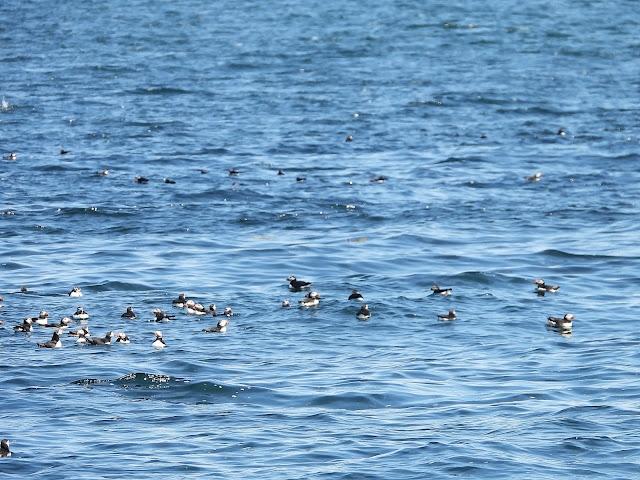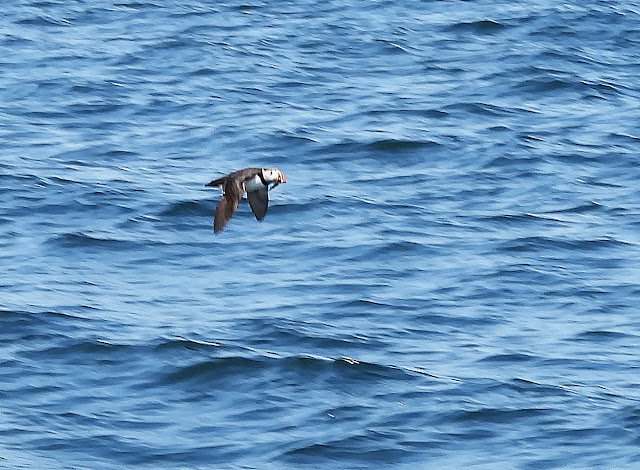Neighbor Shannon and I went on our second summer adventure, this time to Eastern Egg Rock!
We boarded Cap'n Fish's Audubon Puffin and Scenic Cruise, at Boothbay Harbor, for 2.5 hours of fun! The trip out to Eastern Egg Rock takes about an hour. Then, the boat makes 2 passes of the island, which takes about 30 minutes, followed by a return journey to Boothbay Harbor.
This was Shannon's first trip and my second with Cap'n Fish! Such a beautiful day for a boat ride. And, as Shannon's shirt reminds everyone..."Bee Happy!" Truthfully, I was ecstatic!As we cruised through the harbor, we passed by lots of gorgeous sailboats. There was a light wind that was perfect for a day on the water!There is also going to be a Boothbay Harbor Yacht Club Regatta this coming weekend, so the boats were starting to arrive.We also passed by some lighthouses. The first was Burnt Island Light which was built in 1821, so this is its 200th anniversary! It is the second oldest surviving lighthouse in Maine and is located on a 5 acre island that was used to raise and graze sheep. It used to be burned for pasturage.A bit further out we passed by Ram Island Light, which was stationed in 1883. It marks the eastern edge of Boothbay Harbor.Then, we headed east past Pemaquid Point Light at the southern tip of New Harbor.After logging these three lighthouses, we continued east, on the open ocean, to Eastern Egg Rock. Eastern Egg Rock is a treeless island of about 7 acres in area. It is a conservation area that is run by the Audubon Society's Seabird Institute.Eastern Egg Rock is a breeding ground for quite a number of seabirds including Puffins, Black Guillemots, Arctic, Roseate and Common Terns, Laughing Gulls, Common Eider,and Storm Petrels.When we reached the fish rich waters surrounding Eastern Egg Rock, we immediately saw Black Guillemots, who also nest on the island and raise their chicks in crevices. As you can see here, this Guillemot has a caught a fish which it will take back to the chick.There are also gulls galore, the majority of which are Laughing Gulls. Eastern Egg Rock supports the largest colony of Laughing Gulls in Maine.But, wait! What about the Puffins? Well, they were incredible! There were large rafts, groupings of puffins who float and socialize in the ocean together, numbering from 40-50 or more individuals. Wow! In this photo, you see part of a raft in the foreground and part of a second raft in the background.Here is part of a raft that I was able to catch a bit closer up.
Of course, there were lots of puffins doing the serious work of catching fish for their young. This group looked like it was splitting up to gather food.
"Puffins generally gather fish and crustaceans for their pufflings (young puffins), within a 12 mile radius of their nest."
"It takes a special kind of fish diet to feed a growing Atlantic Puffin. A chick can eat more than 2000 fish before leaving the nest."
All the fish a puffling eats "need to have the perfect size, shape, and fat content." Can you see the puffin under the water? Look at the big bubbles on the right bubble field. You can see the red of what is either the beak or the feet.
And, here is the result of the dive. You can see a fish in the puffin's mouth. Pufflings eat white hake and Atlantic herring. The fish must be small and narrow for the chicks to swallow. The bill has a hinge and can open wide enough to hold many hake and herring at one time. The roof of a puffin's mouth has spines that help hold the fish in their bill.
Here is a puffin up close. Because this is the breeding season, the puffin has a very colorful bill. During the winter, the bill is all orange. As the puffin gets older, its bill gets larger.
Here is a view of part of Eastern Egg Rock. There are blinds for researchers to make bird observations from situated around the island. And, only researchers are allowed on this protected island.
On the island, puffins live in burrows in the cracks of the rocks. The males generally excavate the nests which mated pairs use year after year.
I believe that there are 176 breeding pairs of puffins currently on Eastern Egg Rock. The burrows that they live in are numbered.
The pufflings stay in the burrows until they fledge as there are a number of predatory birds, including laughing gulls, who will attack the chicks.
You can see constant puffin activity in and around of the burrows. It was such an exciting place to visit. Because all the passengers had arrived early, the boat was able to stay out at the island for an extra pass along its length. Sweet! If this is a trip you have yet to do, then what are you waiting for? Get on out to Eastern Egg Rock!
























2 comments:
What incredible photography and commentary describing the trip! I feel like I just made the journey myself! Thank you so much for all the work you put into this as it makes me want to go to Eastern Egg myself.
Very neat Laurie!
Post a Comment